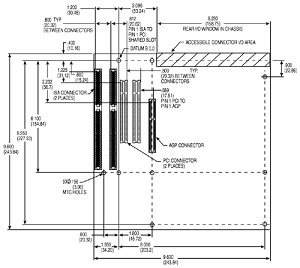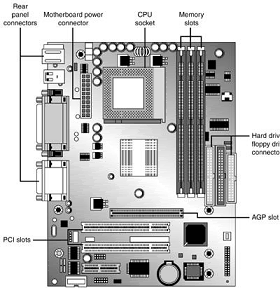Micro-ATX
Micro-ATX is a motherboard form factor Intel originally introduced in December 1997, as an evolution of the ATX form factor for smaller and lower-cost systems. The reduced size as compared to standard ATX allows for a smaller chassis, motherboard, and power supply, thereby reducing the cost of the entire system.
The micro-ATX form factor is also backward-compatible with the ATX form factor and can be used in full-size ATX cases. Of course, a micro-ATX case doesn't take a full-size ATX board. This form factor has become popular in the low-cost, sub-$1,000 PC market.
Currently, mini-tower chassis systems dominate the low-cost PC market, although their small sizes and cramped interiors severely limit future upgradeability. The main differences between micro-ATX and standard or mini-ATX are as follows:
-
Reduced width motherboard (9.6'' [244mm] instead of 12'' [305mm] or 11.2'' [284mm])
-
Fewer I/O bus expansion slots (four maximum, although most boards feature only three)
-
Smaller power supply optional (SFX/TFX form factors)
The micro-ATX motherboard maximum size is only 9.6''x9.6'' (244mmx244mm) as compared to the full-size ATX size of 12''x9.6'' (305mmx244mm) or the mini-ATX size of 11.2''x8.2'' (284mmx208mm).
Even smaller boards can be designed as long as they conform to the location of the mounting holes, connector positions, and so on, as defined by the standard. Fewer slots aren't a problem for typical home or small-business PC users because more components such as sound and video are usually integrated on the motherboard and therefore don't require separate slots.
This higher integration reduces motherboard and system costs. External buses, such as USB, 10/100 Ethernet, and optionally SCSI or 1394 (FireWire), can provide additional expansion out of the box. The specifications for micro-ATX motherboard dimensions are shown in Figure below:

Smaller form factor (called SFX or TFX) power supplies have been defined for optional use with micro-ATX systems, although the standard ATX supply also works fine because the connectors are the same.
The smaller size SFX/TFX power supplies encourage flexibility in choosing mounting locations within the chassis and allows for smaller systems that consume less power overall. Although the smaller supplies can be used, they may lack sufficient power output for faster or more fully configured systems.
Because of the high power demands of most modern systems, most third-party micro-ATX chassis are designed to accept standard ATX power supplies, although micro-ATX systems sold by vendors such as Compaq, HP, and eMachines typically use some type of SFX or TFX power supply to reduce costs.
The micro-ATX form factor is similar to ATX for compatibility. The similarities include the following:
-
Standard ATX 20-pin power connector
-
Standard ATX I/O panel
-
Mounting holes and dimensions are a subset of ATX
These similarities ensure that a micro-ATX motherboard can easily work in a standard ATX chassis with a standard ATX power supply, as well as the smaller micro-ATX chassis and SFX/TFX power supply. The overall system size for a micro-ATX is very small. A typical case is only 12''–14'' tall, about 7'' wide, and 12'' deep. This results in a kind of micro-tower or desktop size.
A typical micro-ATX motherboard is shown in Figure below.

As with ATX, Intel released micro-ATX to the public domain to facilitate adoption as a de facto standard. The specification and related information on micro-ATX are available through the Desktop Form Factors site.